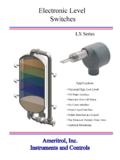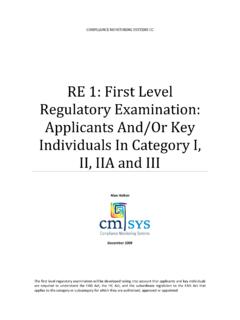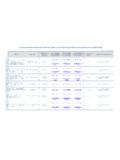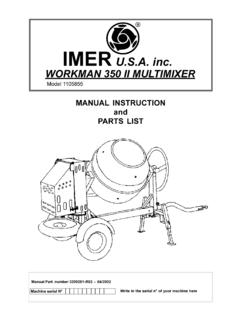Transcription of NISM Series XB: Investment Adviser (Level 2) …
1 NISM Series XB: Investment Adviser ( level 2 ) Certification Examination Sample Questions Chapter 1: 1. The proportion of a public issue of shares allocated to various categories of investors is decided by a. SEBI. b. Issuer c. Stock exchange d. Registrar and Transfer agent 2. In a leveraged Investment in an IPO, the profits to the investor depends upon a. Issue price & listing price b. Cost of borrowing and period of borrowing c. Shares allotted and listing premium d. Interest paid and issue price 3. A high turnover in a stock is an indicator of which of the following a. Higher price b. Higher liquidity c. Lower volatility d. Lower returns 4. Read the following caselet and answer the questions that follow: Mr.
2 A is a conservative investor who is looking to invest in equity markets. He is evaluating shares of VKP Ltd. with a PE ratio of 22, PEG ratio of , dividend yield of a. Which of the following may make VKP Ltd unsuitable for Mr. A as a conservative investor? i. PEG ratio lower than 1. ii. A dividend yield lower than the risk free rate of interest iii. PE ratio higher than peer average iv. Dividend yield higher than dividend yield of index b. The PEG ratio of the company classifies it as i. Overvalued ii. Undervalued iii. Low growth stock iv. High growth stock c. Mr. A is attracted by the high dividend yield of the stock. Which of the following is a likely feature of the Investment going forward?
3 I. High growth in EPS. ii. Low dividend payout iii. High capital appreciation iv. Low earnings growth 5. A decrease in interest rates is likely to see a greater impact on the price of which bond? a. AAA rated 5 year bond b. 15 year Government security c. 30 year bond with 2 years to maturity d. Commercial paper of company Chapter: 2. 1. A nomination made in a mutual fund folio a. Can be changed by the PoA. b. Cannot be cancelled c. Can be cancelled by the first holder in a jointly held account d. Can be changed by all the holders signing for the change 2. In a jointly held folio, the PAN and KYC process has to be complied with by a. All the joint holders b. The first holder only c. Any one of the joint holders d.
4 The joint holders depending upon mode of operation 3. An NRI returning to India and becoming a Resident Indian has to do which of the following with respect to holdings in demat account? a. Operate the existing demat account b. Open a new demat account and transfer holdings c. Change the existing account status to resident d. Open a new account for future Investment and maintain current account for existing investments. 4. Mr. D holds investments in UPP equity scheme. He makes an Investment in an MIP of the same mutual fund. Will it be held under the same folio? a. No, since the scheme is different b. Can be held in either the same folio or different folio c. Can be held only under the same folio d.
5 Will depend upon the mutual fund policy 5. A request for dematerialization of securities may be rejected if a. Securities are not dematerialised at the time of listing b. Securities are not dematerialized within the period specified by SEBI. c. Dematerialization request is not accompanied by R&T verification of signature. d. Delay of more than 15 days in the receipt of physical securities from the day of electronic request. 6. Ms. L takes a loan against her mutual fund holdings. Only a portion of her units are required as security. How will she give effect to this? a. Transfer the required portion to a new folio and mark a lien on it b. Mark lien on the entire holdings, irrespective of the requirement c.
6 Mark lien only on the portion required in the existing folio d. Transfer the required portion to a new folio and make the lender the joint holder Chapter: 3. 1. Which of the following is an indication of indebtedness? a. Expenses Ratio b. Leverage Ratio c. Solvency Ratio d. Net Worth 2. Current cost is translated into a cost in future using which of the following formulae? a. P X (1 + i)n b. P (1 + i)n c. P X (1 - i)n d. P (1 - i)n 3. Read the following caselet and answer the questions that follow: Mr. P earns a gross salary of Rs 50,000, including company's contribution to PF of Rs 5,000; an equal contribution is made by Mr. P. Deductions are made towards loan repayments of Rs 4,000 and investments of Rs 1,000.
7 Mr. P receives Rs 3,000 towards income from past investments. He spends Rs 7,000 on rent, Rs 11,000 on grocery and Rs 15,000 on other expenses. a. What is the net take home salary of Mr. P? i. Rs 40,000. ii. Rs 35,000. iii. Rs 45,000. iv. Rs 5,000. b. What is the monthly surplus of Mr. P? i. Rs 5,000. ii. Rs 10,000. iii. Rs 15,000. iv. Rs 16,000. c. What is the monthly savings of Mr. P? i. Rs 5,000. ii. Rs 10,000. iii. Rs 15,000. iv. Rs 16,000. d. What is the savings ratio of Mr. P? i. ii. iii. iv. Chapter:4. 1. EMI for a loan can be worked out using the _____ function in MS Excel. a. PV. b. NPV. c. EMI. d. PMT. 2. Which of the following depends on the market? a. Strategic asset allocation b.
8 Tactical asset allocation c. Investor risk profile d. None of the above 3. Read the following caselet and answer the questions that follow: Ms. T invests Rs 60,000 in a 10% yielding asset, using leverage of times. Borrowing was at 9% a. How much own funds did Ms. T invest? i. Rs 35,000. ii. Rs 25,000. iii. Rs 42,857. iv. Rs 17,143. b. How much interest did Ms. T need to pay? i. Rs 2,250. ii. Rs 5,400. iii. Rs 3,150. iv. Rs 3,500. c. What was Ms. T's net return? i. Rs 6,000. ii. Rs 2,850. iii. Rs 3,750. iv. Rs 2,500. d. What was Ms. T's return on equity? i. 1%. ii. iii. iv. Chapter:5. 1. Which of the following is NOT considered in the calculation of RoI? a. Realized capital appreciation b. Periodic interest c.
9 Expected dividend d. Unrealized capital appreciation 2. Which of these investments is most likely to be affected by inflation? a. Real estate b. Equity shares c. Bank deposits d. Gold 3. Which of these investments is seen as riskiest? a. Investment with low standard deviation b. Investment with high credit rating c. Investment with low market volatility d. Investment with high beta 4. The benefits of diversification in a portfolio is seen in the form of a. Eliminating risk b. Maximising returns c. Guaranteeing returns d. Enhancing risk adjusted returns 5. Read the following caselet and answer the questions that follow: Mr. C is a 45 year single earning member of his family with a good income.
10 He is saving for different financial goals, some of which are due for funding now. He has a home loan and car loan that he is servicing. a. How would you best categorize Mr. C's risk profile? i. Conservative ii. Moderate iii. Liquidity seeker iv. Aggressive b. What are the assets that will be most suitable for Mr. C given his situation? i. Primarily growth with some income-oriented assets ii. Primarily liquid assets iii. Primarily growth assets iv. Combination of liquid and income-oriented assets c. Mr C. has to park the funds from fixed deposits that have matured for a short period till it will be used for his daughter's education. What will you suggest as a suitable Investment option? i.





